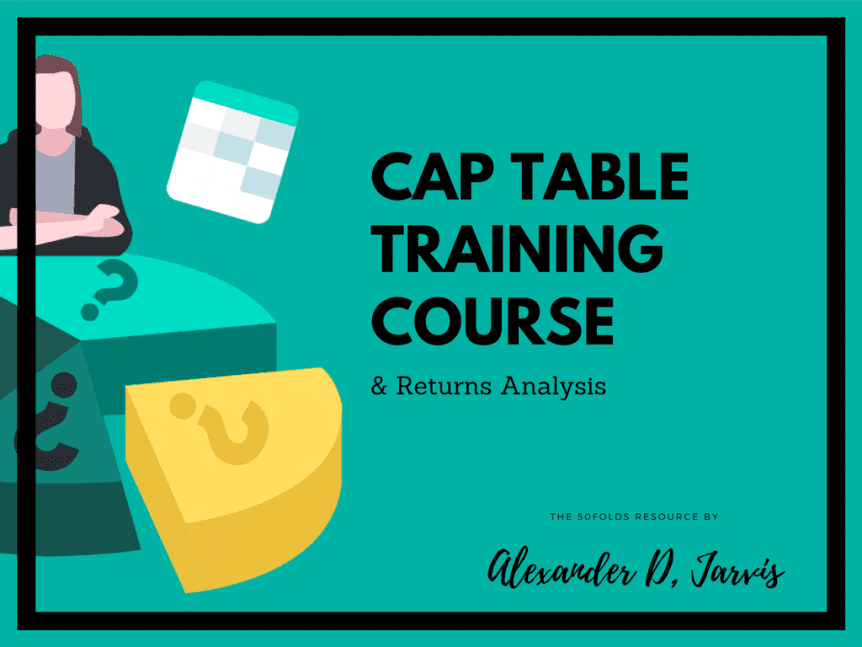This is the first part of the Pro Cap Table training course. In this series we go through the basics you need to know, then work sheet by sheet so you know how to make a seriously kick ass cap table.

There are 14 parts:
- What is a cap table and other important questions
- Cap table dilution step by step example
- Cap table dilution math
- Starting the cap table (The drop down menus we need)
- Shareholders sheet
- Deal calculations
- The cap table sheet
- The assumptions sheet
- Individual shareholder returns sheet
- Returns waterfall calculation
- The ESOP sheet
- The Common sheet
- The convertible notes and warrants sheet
- The preference shares sheets (From Series A to I)
You can join the course and get these sent straight to your mail box here:
What is a cap table?
The full name is capitalization table
A Cap Table is a table or ledger that lists all of your shareholders and sets out what each shareholder owns, how much they own, and the value assigned to the stock they own.
Put another way, it’s an excel file that shows how many dollars everyone is worth at an exit.
Why do you need one?
Every single company needs one.
- Staff want to know how much they own
- Investors want to know what they are buying
- You want to keep track of your stake as your startup raises more capital
Is there such thing as a good and bad cap table?
Cap tables can be bad, they can also be screwed.
A bad cap table can literally kill your fundraise and it has many times. You will likely need to do what is called a ‘recap’ to get the deal done which involves dilution your current investors.
What is a good cap table?
A useful rule is that the founders should own at least 50% after series-a. You can work your way back and forward from there.
A good cap table has the following characteristics:
- The CEO (original founder) owns the most
- The founders own as much as possible
- There is an ESOP already of around 15%
- There aren’t any prior rounds where investors acquired more than 30%
- Ideally, investors own less than 50%
- There are no investors on the cap table that have a bad reputation, or maybe a potential conflict in future (Some corporates)
- There are no advisors or other investors who were given a silly number of shares that make investors question if the founders are dumb (like giving 10% to someone who made a few intros)
What is a deal killer look like?
Most rounds are between 10-25%. If you have given away 30%+ in a round (40% is bad).
So if you have done an angel round at 40%, that’s pretty bad. Founders and prospective investors might try a recap with the existing investors under the threat that there will be no more rounds if there is no recap. That works… sometimes. Sometimes investors just want to watch the world burn.
Are cap tables complicated?
Cap tables, in general, are complicated concepts to wrap your head around. Trust me, it took me time too.
Here is what Facebook’s cap table looks like (and this is just the summary):
Simple cap tables where you have a few founders and staff can be real… simple. We each have a few shares. You divide the amount you have by the total and the % is the % you own. That’s simple, right?
Maybe you do a fundraise (priced round, not a convertible) and the investors buy 20% post. Now investors have 20% and everyone else has 80%. This means everyone before owns 20% less. That’s still simple.
But things get really complicated! You chuck in RSUs, warrants, convertible notes and a couple of priced rounds, and that’s painful, but easily manageable if you have a good template! You just input boxes and it works… Where the real complication comes in is when reality creeps in. You fire staff or they quit, shares exercise and convert from the ESOP to common, convertibles convert into shares. Yes, this is still all doable, but there’s a lot more to learn.
There’s a basic intro for you to have a ponder. Next, we are going to get into dilution math.
Click here to continue
Dilution step by step exampleShow off to your friends. Hit a social button to share the cap table love!



Comments 2
Author
Great information, thank you Alexander!
Author
Thanks for the kinds words, Milena 😉